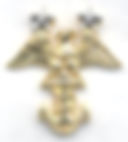NJROTC RATES/RANKS AND U.S. NAVY RATES/RANKS
GENERAL
1. Cadet rates, ranks, promotions and position assignments are earned based on individual performance and demonstrated potential. Many factors are evaluated by the naval science instructors before awarding rates, ranks, promotions and advancement, and before cadet billet assignments are made. Cadets must continually demonstrate:
a. High moral standards and good conduct
b. Proper appearance in school and in unit uniform
c. Acceptable academic achievement
d. Acceptable performance in carrying out assigned NJROTC responsibilities
e. Acceptable level of participation in NJROTC activities and programs
2. Students entering NJROTC for the first time are usually assigned the grade of Cadet Seaman Recruit, or in some schools the grade of Seaman Apprentice. Advancements beyond the initial grade in the enlisted rates are often based on performance, time in the unit, position assignment and by completing certain military knowledge advancement tests. Achievement of officer status requires an individual who has demonstrated superior quality leadership, integrity, personal appearance, conduct and patriotism. NJROTC cadet rates and ranks, from the lowest to the highest, are as follows:
3. All rate and rank promotions are determined by the naval science instructor. Unacceptable performance could result in a demotion.


• There is no collar device for this rate. • Assigned to new cadets in the process None of learning the NJROTC program.

The collar device is an eagle and two stars perched on a fouled anchor. • Generally a third or fourth year cadet. • The SNSI may assign a Master Chief Petty Officer billet to the battalion chief petty officer.


Cadet officers are generally third or fourth year cadets that have shown aptitude for high leadership positions. Officers are selected from the enlisted rates to fill specific positions as noted below.

• The collar device is a single gold bar. • Generally a third or fourth year cadet. • The first junior officer assignment which may include junior officer on company staffs, public affairs, assistant supply, platoon commander, or assistant drill team commander.

• The collar device is five attached gold bars. • The highest rank that can routinely be attained by a cadet in NJROTC. • Assignments include battalion commander and regimental ma commander.

Cadet officers are generally third or fourth year cadets that have shown aptitude for high leadership positions. Officers are selected from the enlisted rates to fill specific positions as noted below.




Vocabulary Words
Rate
Level of proficiency within an enlisted rating, similar to a pay grade.
Ratings
General grouping of enlisted personnel by job specialty.
Rank
Relative position of authority among officers and petty officers.
Officer’s Rank
An officer’s rank refers to his or her official title, e.g. Ensign, Lieutenant Commander, Captain, etc.
Promotion(in rank)
When an officer moves up to the next rank and pay grade, they have earned a promotion.
Advancement (in rate)
When enlisted personnel move up to the next higher rate in their rating specialty, they have advanced in rate.
Pay Grade
Level of military pay, from E-1 (Seaman Recruit) to E-9 (Mater Chief Petty Officer), from W-1 (Warrant Officer) to W-5 (Chief Warrant Officer) and from O-1 (Ensign) to O-10 (Admiral).
CPO, SCPO, MCPO
Chief Petty Officer, Senior Chief Petty Officer and Master Chief Petty Officer. With the exception of the Master Chief Petty Officer of the Navy, this is the highest rank attainable by enlisted personnel while still in the enlisted category.
Warrant Officers
Warrant officers are senior specialists who supervise the operation of equipment and weapons. They bridge the gap between commissioned officers and enlisted personnel. They are like the journeymen or master tradesmen in civilian life.

